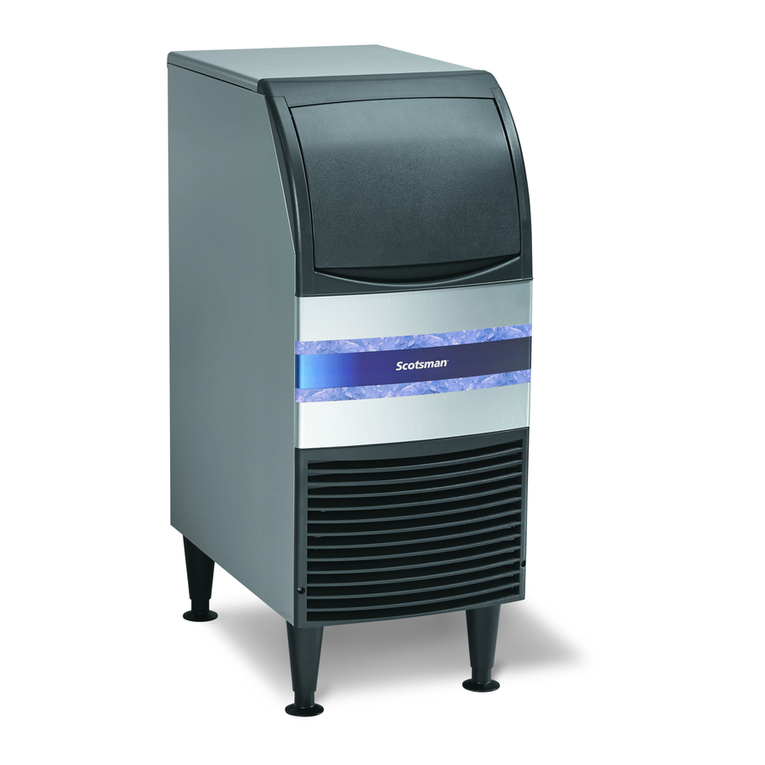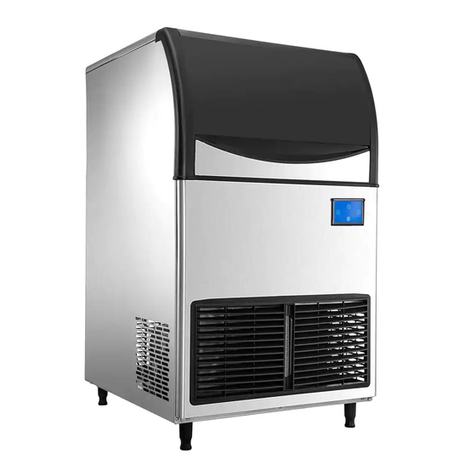PRODIS C Series User manual

TECHNICAL MANUAL
ECO SERIES
ICE CUBE MAKERS
MODELS:
ECO 25
ECO 35
ECO 45
ECO 60
ECO 80
ECO 120
CAREFULLY READ THE INSTRUCTIONS CONTAINED IN THIS MANUAL SINCE THEY
PROVIDE IMPORTANT INFORMATION RELATIVE TO SAFETY DURING INSTALLATION,
USE AND MAINTENANCE.
C SERIES
C25
C35
C45
C45P
C60
C60P
C80
C135

2
INDEX
1. INTRODUCTION...............................................................................................................................4
1.1.- Warning........................................................................................................................................4
1.2.-Reception of the machine ..............................................................................................................6
2. INSTALLATION ................................................................................................................................7
2.1.- Placing of the ice maker ...............................................................................................................7
2.2.-Levelling of the ice maker ..............................................................................................................8
2.4.-Minimum distance to obstacles......................................................................................................8
2.5.- Water supply connection ..............................................................................................................9
2.6.-Drain connection............................................................................................................................9
2.6.1.- Gravity drain...........................................................................................................................9
2.6.2.- Drain Force Connection .......................................................................................................10
2.5.- Electrical connection...................................................................................................................11
3. PRIOR CHECKING AND START-UP..............................................................................................11
3.1.- Prior checking.............................................................................................................................11
3.2.- Start-Up ......................................................................................................................................12
4. SEQUENCE OF OPERATION ........................................................................................................13
4.1. Control Board...........................................................................................................................14
4.2.- Alarms ........................................................................................................................................15
4.2.1 Safety high pressure switch....................................................................................................16
4.2.2 Long harvest ..........................................................................................................................16
4.2.3 Ice production cycle timeout ...................................................................................................16
4.2.4 Faulty temperature probe .......................................................................................................16
4.3 PCB push button function .............................................................................................................16
4.4 DRAIN FORCE.............................................................................................................................17
4.4.1 SEQUENCE OF OPERATION ..........................................................................................17
4.4.2 CONTROL BOARD...........................................................................................................19
5 Refrigeration diagram......................................................................................................................20
6 MAINTENANCE AND CLEANING PROCEDURES.........................................................................21
6.1.- Cleaning water distribution system .............................................................................................21
6.2.- Cleaning water distributor and injectors ......................................................................................23
6.3.- Cleaning the bins........................................................................................................................24
6.4.- Cleaning the condenser..............................................................................................................24
6.5.- External cleaning of the machine................................................................................................25

3
6.6.- Water leakage checking .............................................................................................................25
6.7.- MAINTENANCE TABLE .............................................................................................................25
7 USER TROUBLESHOOTING GUIDE .............................................................................................26
7.1. general questions ........................................................................................................................26
7.2. drain force....................................................................................................................................27
8 TECHNICAL DATA .........................................................................................................................28

4
1. INTRODUCTION
Thank you for purchasing a ‘ECO’ Ice Cube Maker. You have purchased one of the most reliable ice-
making products on the market today.
Carefully read the instructions contained in this manual since they provide important information relative
to safety during installation, use, and maintenance.
1.1.- WARNING
This appliance is intended to be used in household and similar applications such as staff kitchen areas in
shops, offices and other working environments; farmhouses and by clients in hotels, motels and other
residential type environments; bed and breakfast type environments; catering and similar non-retail
applications.
The installation of this equipment should be done by the Service Department.
The socket should always be placed on an accessible location.
When positioning the appliance, ensure the supply cord is not trapped or damaged.
Do not locate multiple portable socket-outlets or portable power supplies at the rear of the appliance.
Always disconnect the power supply from the machine before any cleaning or maintenance service.
Any change needed on the electrical installation for the appropriate connection of the machine, should
be exclusively performed by qualified and certified professional personnel only.
Any use by the ice maker not intended to produce ice, using potable water, is considered inappropriate.
It is extremely dangerous to modify or intend to modify this machine and will void warranty.
The appliance is not to be used by persons (including children) with reduced physical, sensory or mental
capabilities, or lack of experience and knowledge, unless they have been given supervision or
instruction.
Children being supervised not to play with the appliance.
Connect to potable water supply only. To see “Installation” chapter (5).
This machine is not intended to be used outdoors nor exposed to the rain.
The machine should be connected using the power cord supplied with the equipment.
In case the supply cable is damaged, it should be replaced by a cable of special assembly to be
furnished by the manufacturer or after-sales service. Such replacement should be performed by qualified
technical service only.
It is mandatory to ground the equipment to avoid possible electric shock on individuals or damages to
the equipment. The machine should be grounded pursuant local and/or national regulations. The

5
manufacturer shall be held harmless in case of damages arising due to the lack of the ground
installation. To see “Installation” chapter (7).
In order to assure the proper operation and efficiency of this equipment, it is extremely important to
follow the recommendations of the manufacturer, especially those related to cleaning and maintenance
operations, which should be performed by qualified personnel only.
CAUTION: The intervention of non-qualified personnel, besides of being dangerous, could result in
serious malfunctioning. In case of damages, contact your distributor. We recommend always using
original spare parts.
The company reserves the right to make changes in specifications and design without prior notice.
This signal indicates “Risk of fire / Flammable materials” because of the use of flammable refrigerant.
For compression-type appliances that use flammable refrigerants should additionally consider the
substance of the warnings listed below:
•Keep ventilation openings, in the appliance enclosure or in the built-in structure, clear of
obstruction.
•Do not use mechanical devices or other means to accelerate the defrosting process, other than
those recommended by the manufacturer.
•Do not damage the refrigerant circuit.
•Do not use electrical appliances inside the food storage compartments of the appliance, unless
they are of the type recommended by the manufacturer.
•Do not store explosive substances such as aerosol cans with a flammable propellant in this
appliance.
In case of a flammable refrigerant leakage:
•Do not generate flames close to the appliance.
•Do not switch on/off or plug in/off the appliance.
•To ventilate immediately the area where appliance is located by opening doors and/or windows.
•To call to an authorized technical service.
Disposal of the ice maker: The company encourages to follow the regulations of each country regarding
eco-friendly disposal of electric and electronic devices such this one. User who is wanting to dispose of
this equipment must contact the manufacturer and follow the method to appropriate differentiated
collection for the subsequent treatments.

6
1.2.-RECEPTION OF THE MACHINE
Inspect the outside packing. In case of damages, make the corresponding claim to the carrier. To
confirm the existence of damages, unpack the machine in the presence of the carrier and state any
damage on the equipment on the reception document or freight document.
Always state the machine number and model. This number is printed on three locations:
(1) Packing: On the outside, it contains a label with the serial number.
(2) Exterior of the unit: On the back panel of the unit, there is a label with the same characteristics as the
previous one.
(3) Nameplate: On the back of the machine.
Check that in interior of the machine the installation kit is complete and comprises:
•Ice scoop
•¾ inlet water hose
•22 mm drain hose
•1 filter
•User manual.
•Warranty and serial number.
CAUTION: All packing elements (plastic bags, carton boxes and wood pallets) should be kept outside
the reach of children, as they are a source of potential hazard.

7
2. INSTALLATION
2.1.- PLACING OF THE ICE MAKER
This ice maker is not designed for outdoor operation. The icemaker should not be located next to ovens,
grills or other high heat producing equipment.
The ECO machines are designed to operate at room temperature between 10ºC and 43ºC. There may
be some difficulties in ice cube removal under the minimum temperatures. Above the maximum
temperature, the life of the compressor is shortened and the production is substantially lower.
The air flow in air-condensed machines enters through the front grille, entering on the right front and
exiting on the left front side. In addition, the unit is equipped with a rear air vent. Do not obstruct the front
grille with any objects.
The unit can operate embedded, but with a reduction in output.
In case the front louver is not enough, the exit is either total or partially obstructed or due to its
placement it will receive hot air from another device, we recommend, in case it is not possible to change
the location of the machine, TO INSTALL A WATER CONDENSER.
IT IS IMPORTANT THAT THE WATER PIPING DO NOT PASS BY OR NEAR SOURCES OF HEAT SO
AS NOT TO LOSE ICE PRODUCTION.
The location must allow enough clearance for water, drain and electrical connections in the rear of the
ice machine. It is important that the water inlet piping does not pass near sources of heat so as not to
lose ice production.

8
2.2.-LEVELLING OF THE ICE MAKER
Use a level on top of ice machine in order to ensure the equipment is perfectly leveled.
Screw the leveling legs onto the bottom of the ice machine as far as possible.
Move the machine into its final position.
Use a level on top of the ice machine. Adjust each leg as necessary to level the ice machine from front to
back and side to side.
2.4.-MINIMUM DISTANCE TO OBSTACLES
Please see below the recommended minimum distances for proper operation and efficient service.

9
CONNECTION DIAGRAM:
The location must allow enough clearance for water drain and electrical connections in the rear of the ice
machine
2.5.- WATER SUPPLY CONNECTION
The quality of the water supplied to the ice machine will have an impact on the time between cleanings
and ultimately on the life of the product (mainly in water cooled units). It also will have a remarkable
influence on the appearance, hardness and flavor of the ice.
Local water conditions may require treatment of the water to inhibit scale formation, improve taste and
clarity. If you are installing a water filter system, refer to the installation instructions supplied with the filter
system.
Pressure should be between 0.1MPa and 0.6MPa (1 and 6 bar). If pressure overpasses such values,
install a pressure regulator.
The water connection needs to be dedicated (only piece of equipment hooked to the water line).
ATTENTION: The machine shall be plumbed (with adequate backflow protection) according to
applicable national and local regulations.
2.6.-DRAIN CONNECTION
2.6.1.- GRAVITY DRAIN
Drainage should be located lower to the machine level, 150mm minimum.
It is convenient that the drain hose is 30mm inside diameter and with a minimum gradient of 3cm/metre,
see figure.

10
2.6.2.- DRAIN FORCE CONNECTION
This version of drain force allows an installation of the machine where the drain can be located 30
meters horizontally and 1.5 meters high from the machine's water outlet.
If the drain pipe runs incorrectly, the pump may not be able to drain the water, because the flow of the
pump may be influenced due to the existence of stored air within the circuit.
IncorrectIncorrectCorrect

11
2.5.- ELECTRICAL CONNECTION
It is mandatory to ground the equipment. To avoid possible electric shock on individuals or damages to
the equipment, the machine should be grounded pursuant local and/or national regulations as the case
may be.
The manufacturer shall be held harmless in case of damages arising due to the lack of the ground
installation.
In case the supply cable is damaged, it should be replaced by a cable of special assembly to be
furnished by the manufacturer or after-sales service. Such replacement should be performed by qualified
technical service only.
The machine should be places in such a way as to allow a minimum space between the back and the
wall to allow an easy access and without risks to the cable plug.
Safeguard the socket. It is convenient to install adequate switches and fuses.
ATTENTION: The appliance requires an independent power supply of proper capacity. See the
nameplate for electrical specifications. Failure to use an independent power supply of proper capacity
can result in a tripped breaker, blown fuse, damage to existing wiring, or component failure. This could
lead to heat generation or fire.
Voltage is indicated in the nameplate and on the technical specifications section of this manual. Variation
on voltage above the 10% stated on the nameplate could result on damages or prevent the machine
start-up.
3. PRIOR CHECKING AND START-UP
3.1.- PRIOR CHECKING
a) Is the machine leveled?
b) Voltage and frequency are the same as those on the nameplate?
c) Are the drains connected and operating?
d) Will the ambient temperature and water temperature remain in the following range?
ROOM
WATER
MAXIMUM
43ºC
30ºC

12
MINIMUM
10ºC
10ºC
e) Is water pressure appropriate?
MINIMUM
0.1MPa (1 bar)
MAXIMUM
0.6 MPa (6
bar)
In case inlet water pressure is higher than 0.6 MPa, install a pressure regulator.
3.2.- START-UP
Once the installation instructions are followed (ventilation, site conditions, temperatures, water quality,
etc.), proceed as follows:
1.- Open the water inlet. Verify the no existence of leakages.
2.- Open the door and remove the protection elements on the curtain.
3.- Verify that the curtain moves freely.
4.- Connect the machine to the power supply.
5.- Push the switch on the machine front side.
6.- Verify that there are no vibrations or frictions on the elements.
7.- Close door
8.- Verify the ice cubs with the pictures below. Adjust production time switches (see table in 4.1, switches
1-4 (tf)) to make the ice cubes with the right shape.
Damages due to the lack of maintenance and cleaning operations are not included on the warranty.
Too big
Just right Too small

13
4. SEQUENCE OF OPERATION
Once you connect the machine there is a time delay of 140” during which the water valve is activated to
ensure the water tray is filled. Compressor, pump will be off.
Once the time is up, it continues with a harvest cycle and the compressor starts.
After the harvest, the ice production starts, so the pump starts working. The pump, recirculates the water
from the water tray to the upper nozzles (#2) distributor which provides a sheet of water that sprays each
ice cube row in the evaporator (#1), in which the water starts freezing and making the ice.
When the temperature probe (#3) at the end of the evaporator reaches an adjusted value Tc (-12/-8°C) ,
the fabrication continues the fixed time with the combination of dip-switches 1-4 (see table). This way we
can ensure the filling of the ICE CUBE is correct in different working conditions.
Once the fabrication is over the harvest phase starts. The pump stops, the hot gas and the water inlet
valves open. When the evaporator temperature probe (#3) reaches an adjusted value Tg (4/0°C)the
harvest continues the fixed time with the combination of dip-switches 5-7 (see table). Water is poured
over the evaporator helping unstick the ice cubes from the plastic frame.
After the harvest cycle, the machine comes back to the production cycle.
At the beginning of each Harvest cycle, the PCB checks if the Thermostat is open or close. Once the ice
bin is full and the ice cubes cover the thermostat tube (#4), the contact open, so when the harvest
begins, the machine will stop until the contact of the thermostat close again. When it close, it starts with
a harvest cycle and then it will continue with the production cycle again.

14
4.1. CONTROL BOARD
PCB connections
Outputs
C
Compressor
B
Water pump
EA
Water inlet valve
GC
Hot gas valve.
Inputs
SC
Evaporator temperature NTC probe
Ps
Safety pressure switch
SW3
PCB push button
T1
Stock thermostat
LED signalling
Next to each out relay there is an orange led. Signals relay on
Next to each input terminal there is an orange led marking input active.
There are four additional red leds that signals machine status (continuous) or alarm (flashing)
Status signaling . Continuous led
LE1
LE2
LE3
LE4
Start up delay
X
Ice cycle T>Tc
X
X
Ice cycle T<Tc
X
Harvest t<tg
X
X
Harvest t>tg
X
Full bin
X
Alarm signaling . Flashing led
LE1
LE2
LE3
LE4
Safety pressure switch
X
Ice cycle timeout
X
Harvest cycle timeout
X
Faulty temperature probe
X

15
Dip switches setting
dip
Descripción (* factory setting)
1-4 (sw1-
1/4)
tf - ice production timer. See table
5-7 (sw1-
5/7)
tw - Water input timer. See table.
8 (sw1-8)
Tc - Evaporator temperature for timer start.
ON=-12ºC / OFF=-8ºC
9 (sw2-1)
Tg (Hot gas temperature). ON=+4ºC / OFF=+0ºC
10 (sw2-
2)
Safety high pressure switch trip function.
ON= automatic reset (minimum stop 30 min.)
OFF= manual reset (power OFF-ON)
11 (sw2-
3)
Timeout alarms operation
ON = activated
OFF = unactivated
12 (sw2-
4)
Software selection.
Always ON
ICE / WATER TIMER SETTING
SW1
TF (MIN)
SW1
TW (SEG)
1
2
3
4
5
6
7
OFF
OFF
OFF
OFF
6
OFF
OFF
OFF
40
ON
OFF
OFF
OFF
8
ON
OFF
OFF
60
OFF
ON
OFF
OFF
10
OFF
ON
OFF
80
ON
ON
OFF
OFF
12
ON
ON
OFF
100
OFF
OFF
ON
OFF
14
OFF
OFF
ON
120
ON
OFF
ON
OFF
16
ON
OFF
ON
140
OFF
ON
ON
OFF
18
OFF
ON
ON
160
ON
ON
ON
OFF
20
ON
ON
ON
180
OFF
OFF
OFF
ON
22
ON
OFF
OFF
ON
24
OFF
ON
OFF
ON
26
ON
ON
OFF
ON
28
OFF
OFF
ON
ON
30
ON
OFF
ON
ON
32
OFF
ON
ON
ON
34
ON
ON
ON
ON
36
4.2.- ALARMS
They detect operational malfunctions. They are indicated with the flashing status Leds LE1-4.
During some alarms a second operation retry attempt is carried out and if repeated again, the machine
will stop. Signaling should be indicated since the first failure occurs. If the second retry attempt is ok, the
signaling will switch off.
In case that a machine stop has been caused by alarm, the reset is done by switching OFF and ON the
main switch. If the dip-switch 11 OFF, time alarms are not to be followed.

16
4.2.1 SAFETY HIGH PRESSURE SWITCH
When the pressure contact (P) trips, instantly, all outputs switch over to off position.
When it is closed again, there are two possibilities:
- Dip-switch 10 OFF. Manual reset. The machine remains stopped until reset to Initial start-up.
- Dip-switch 10 ON. Automatic reset. The machine check pressure switch status every 30 min. When
closed, the machine will continue at the position where it was.
* Signalling: Flashing LE1.
4.2.2 LONG HARVEST
If the harvest time is longer than 5 min., the harvest is interrupted, switching over to the production cycle.
If the same happens again at the next harvest, the machine will stop.
* Signalling: Flashing in LE3.
4.2.3 ICE PRODUCTION CYCLE TIMEOUT
If during the production cycle, evaporator temperature probe has not reached the set temperature Tc in
more than 60 min, the machine will stop until reset.
* Signalling: Flashing in LE2.
4.2.4 FAULTY TEMPERATURE PROBE
If PCB detects that evaporator temperature probe is broken or unconnected, the machine will stop
* Signalling: Flashing in LE4.
Probe type is NTC and resistance value must be 10kΩ at 25°C.
4.3 PCB PUSH BUTTON FUNCTION
Function depends on the unit status:
- Start up timer: Finish initial delay y passes to ice production stage
- Ice production. Switches to harvest
- Harvest. Switches to Ice production
Wash cycle activation.
Keep pressed the button while switching on main front switch. Wash cycle is activated and only the
water recirculation pump is running. There is a maximum time for this cycle of 30 min. After this time,
pump stops.
Wash cycle is finished by switching off main power.
Read cleaning and sanitizing instructions for proper usage of this function.

17
4.4 DRAIN FORCE
4.4.1 SEQUENCE OF OPERATION
While the machine is turn on, there is water that need to be evacuated between each cycle. There are 2
possible outlet water, one is if the ice in the storage bin melts (#1) and the other is when the production
time ends, the water electrovalve opens and fills the water tray(#2) to renovate the water. The excess of
water goes out by the overflow (#3) to the drain force water reservoir (#4).
When the water reservoir is full of water covering the 2 electrodes (#5), the pump (#6) turns on and
evacuates water for 5 seconds. After 5 seconds, the pump turns off if the electrodes are not covered by
the water, otherwise, the pump will start again for 5 seconds.
In case that the system does not work for any issue, the water will flood the ice bin. There is a ventilation
tube (#7) that allows the system to remove any air that may remain in the water reservoir. The Vent tube
must be always over the mouth of the front door (#8).
In case that the pump works for 5 minutes continuously, it will stop for 5 seconds automatically in order
to refrigerate.
The system has a way to evacuate the water inside the water reservoir in a manual way. There is a plug
(#9) in one of the plastic tube, by retiring this plug, it is possible to evacuate all the water.
Also, the system has a Check valve(#10) that does not allow the water to came back to the water
reservoir.

18

19
4.4.2 CONTROL BOARD
PCB connections
Outputs
B
Water pump
Inputs
Lw
Water Level Sensor
LED signalling
There are two LEDs that signals machine status
Status signaling. Continuous led
LED5
LED6
PUMP RUNNING
X
WATER LEVEL SENSOR
ON
X

20
5 Refrigeration diagram
This manual suits for next models
8
Table of contents
Other PRODIS Ice Maker manuals



















